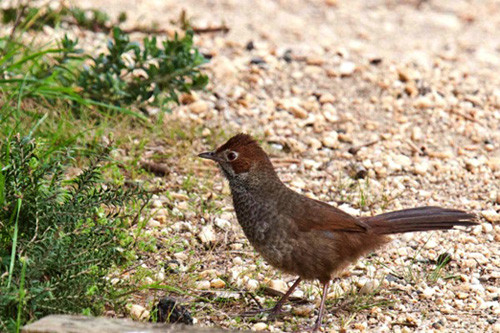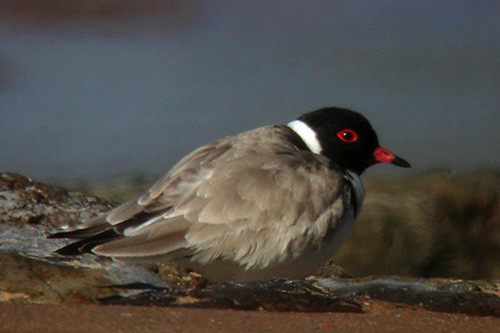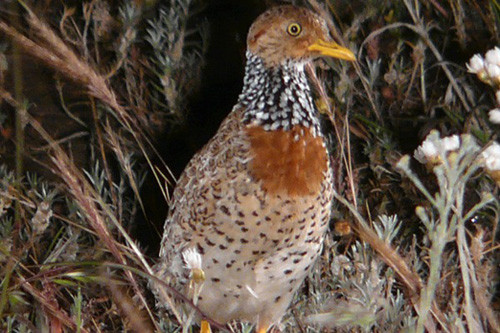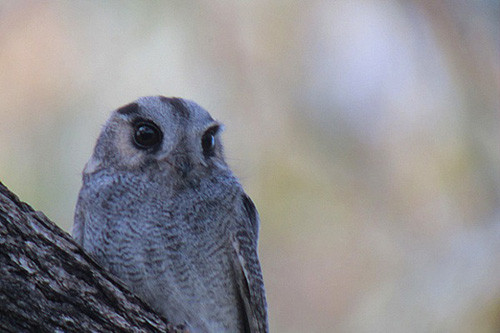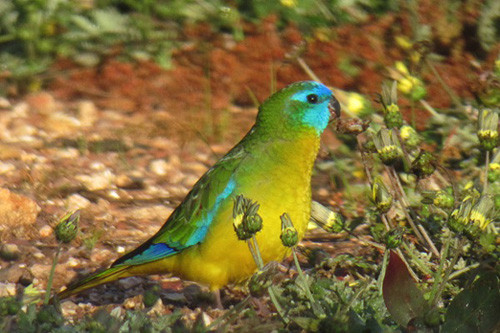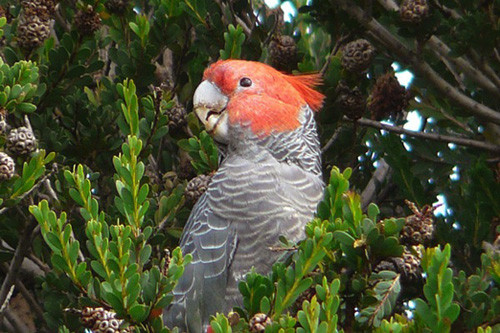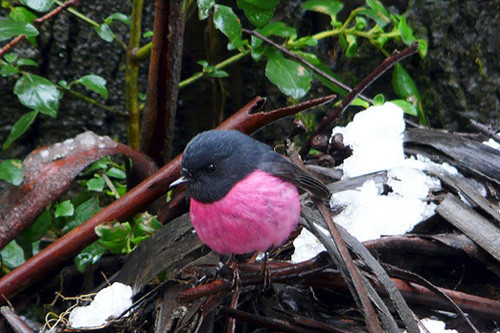 Tasmania has a host of endemics including the charismatic Pink Robin.
Photo: David Fisher
Tasmania has a host of endemics including the charismatic Pink Robin.
Photo: David Fisher Our southeastern Australia tour passes through a wide variety of habitats and climates. The Victoria countryside may seem reassuringly familiar after two centuries of European settlement, but the birds that inhabit it are anything but. Large flocks of parrots feed along the highways and multicolored fairy-wrens and honeyeaters fill the woods, while kangaroos graze in the paddocks and Echidnas shuffle in the understory of giant eucalyptus trees. The area around Deniliquin in southern New South Wales seems much wilder, on the edge of the outback, and is home to major ornithological attractions, including the almost mythical Plains-wanderer. The Mallee around Little Desert National Park hosts the stately and shy Malleefowl, the world’s southernmost megapode, and often an array of spring-blooming terrestrial orchids. Tasmania holds many more avian treasures from the flightless and endemic Tasmanian Native-hen to the dazzling Pink Robin.
This tour can be taken in conjunction with our Australia: Queensland and New South Wales tour.
Day 1: The tour starts in Melbourne at 2 p.m., when there will be an excursion to a local park to see our first colorful Australian birds, including Galahs, Sulphur-crested Cockatoos, Red-rumped Parrots, and Laughing Kookaburras. As well as these widespread species, this park has in the past produced less common birds such as Tawny Frogmouth, Purple-crowned Lorikeet, Crested Shrike-Tit, and Varied Sittella. It will be a relaxed affair, designed to introduce us to the colours and sounds of Australian birds. Night near the Melbourne Airport.
Day 2: We’ll visit the area southwest of Melbourne, where we will start by birding along a stretch of the Great Ocean Road, widely regarded as one of the most scenic drives in the world. At the Point Addis and Airey’s lookouts we’ll spend some time seeking out Rufous Bristlebirds as they lurk underneath the dense coastal heath. If conditions are good we have an excellent chance of tracking down Southern Emu-Wren and Striated Fieldwren around Airey’s Inlet. Then we will head back north to visit the amazing Werribee Sewage Works. The expansive ponds and shoreline at this surprisingly natural facility hold a wealth of birds. We’ll have our fill of waterfowl and waders perhaps including some of the rarer species such as Freckled and Musk Ducks, Fairy Tern, or Banded Stilt. Raptors are in evidence as well, with Swamp Harrier, Whistling Kite, Brown Falcon, and Nankeen Kestrel all regular. In the saltbushes and reedbeds we should find Striated Fieldwren and Australian Reed Warbler, and along the muddy verges we might spot an Australian Spotted Crake or flock of Black-tailed Native-hens. Brolga are possible too, out in the open fields, and with luck we might spot a Banded Lapwing.
In the late afternoon we’ll head a bit west to the rolling hills and dry Eucalypt forest of You Yangs National Park. We’ll pass by agricultural fields that may well hold our first flocks of Galah or mixed flocks of Little and Long-billed Corellas foraging in the shorter grass. We’ll look out too for hulking Wedge-tailed Eagles and perhaps foraging flocks of Musk, Purple-crowned, and Rainbow Lorikeets. The park itself is excellent for many dry-country birds, and we should encounter Red-rumped Parrot, White-naped, Black-chinned, and Brown-headed Honeyeaters, several species of Thornbill, Rufous and Golden Whistlers, Willie-Wagtail, Magpie-lark, and the perky Scarlet Robin. It will be a whirlwind of a day, with loads of new birds to digest! Night near the Melbourne Airport.
Day 3: Today we’ll spend the morning around Melbourne, looking for a selection of “staked-out” species including, with luck, Powerful Owl, and then head east of the city into the Yarra Ranges and on to Healesville, our base for the next two nights. Our actual itinerary varies from year to year as we take advantage of the local birding conditions. Once near Healesville, we’ll find ourselves surrounded by wet forests, laden with large ferns in the understory and towering canopy trees; a very different environment from the coastal plain of the day before. After dinner there will be a spotlighting trip in search of Greater Sooty Owl, and we should see Greater Gliders and, if we’re lucky, a Yellow-bellied Glider as well. Night in Healesville.
Day 4: Today we’ll make a very early start to visit Badger Weir, where the great attraction is Superb Lyrebird, indisputably the world’s most remarkable mimic. It’s a bird that is easy to hear but hard to see. While walking the forest tracks and around the campgrounds in search of the great imitator, we should see delicate Rose Robins and the spectacular Eastern Spinebill, among others. After breakfast we’ll visit a local park where Australian King Parrots and Common Bronzewings are abundant and provide excellent photographic opportunities. We’ll also see an active Satin Bowerbird bower and watch how the male decorates it with various blue items to entice females to visit and mate. In the afternoon we’ll visit Toolangi State Forest to search for Gang-gang Cockatoo, Pink Robin, Pilotbird, and Olive Whistler and to marvel at the ancient Mountain Ash trees, some of which are over 200 feet tall! Night in Healesville.
Day 5: If anything eluded us the previous day we’ll have an opportunity for a morning return to Toolangi or another nearby park, and then we’ll head north to the small country town of Chiltern. Our route will take us out of the coastal mountains into a swath of agricultural lands dotted with copses of trees, villages, and open fields. We should arrive by mid-day, and we’ll have some time to bird around the town of Chiltern, finding birds like Black-chinned, Brown-headed, White-naped, Fuscous, and Yellow-tufted Honeyeaters. Thornbills can be common here, and we’ll spend some time teasing apart Yellow, Striated, Yellow-rumped, and Buff-rumped. Given time we might perhaps even take in our first visit to Chiltern-Mount Pilot National Park. Night in Chiltern.
Day 6: Chiltern-Mount Pilot National Park was set up in 1997 to protect the box-ironbark forest that once covered much of northeast Victoria. It is now home to one of the few scattered populations of the endangered Regent Honeyeater, and during our morning in the park we’ll search for this scarce species. Other birds that we hope to see include Turquoise Parrot, Speckled Warbler, and Fuscous and Painted Honeyeaters, the last a truly beautiful bird in its own genus. After a morning in the park we’ll head north to Deniliquin, crossing the Murray River and into New South Wales in the process. We’ll arrive in the Deniliquin area in time for a late lunch. While this area has many interesting species, the main reason for visiting Deniliquin is to search for Plains-wanderer, a unique species in its own family and our primary focus. It is a cryptic, buttonquail-like bird that can be very hard to find, but by driving at night across the area’s short-grass native pasturelands, accompanied by local expert Phil Maher, we have a very good chance of spotting this fascinating and rarely seen bird. Other possibilities on our night drive include Banded Lapwing, Inland Dotterel, and chances for Stubble Quail and Little and Red-chested Button-quails. Night in Deniliquin.
Day 7: The time of our start will depend on how late we stay out the previous night, but we’ll spend the day in the Deniliquin area searching for local specialties that we are unlikely to see elsewhere during our tour, such as Australasian Bittern, Inland Dotterel, Superb Parrot, Crested Shrike-tit, and Gilbert’s Whistler. We’ll spend the day birding with local expert Phil Maher, whose intimate knowledge of the region is unsurpassed. We’ll likely find roosting Australian Owlet-Nightjars peeking out from tree cavities, and a bit further out west onto the plains we should find Striped Honeyeater and the dazzling White-winged Fairy-Wren. In the evening we’ll have a second chance for Plains-wanderer should we have missed it the previous evening. Night in Deniliquin.
Day 8: We’ll spend another morning birding around Deniliquin with Phil, and then in the afternoon we’ll drive west, back into Victoria. As we travel along the Murray Valley highway through Kerang, we’ll enter a large area of wetlands, collectively called the Kerang Lakes, and we’ll make frequent stops to take in the masses of birds here. A large ibis rookery, with both Australian White and Straw-necked Ibis (often 20,000 birds), will be a particularly impressive sight. We’ll also spend a bit of time tracking down birds like Orange Chat in the adjacent brushlands. Waders can be quite common here, including wintering Common Greenshank and Marsh, Wood, Curlew, and Sharp-tailed Sandpipers. As the afternoon wanes, we might spot a Buff-banded Rail or Baillon’s Crake in the reeds, or with some extreme luck an Australasian Bittern or Australian Little Bittern. We’ll then drive on a bit further to our base for the night in the tiny town of Swan Hill.
Day 9: We’ll begin by visiting two small mallee reserves just a bit south of town. Although small, the Goschen Bushland Reserve has a history of attracting some of the rarer inland species. Stands of Long-leafed Emu-Bush should be in flower during our visit, and we’ll look for nomadic honeyeaters like Black, White-fronted, or (rarely) Pied foraging in the flowers. The park can be good for the dazzling Crimson Chat, handsome Hooded Robin, retiring Little Buttonquail, and nomadic Budgerigars, Cockatiels, and Zebra Finches. The nearby Tresco West Bushland Reserve holds similar species, as well as birds like Red-backed Kingfisher, Variegated Fairy-Wren, and Rainbow Bee-eater. Which of these species is present each year is dependent on weather, as many of them might move hundreds of kilometers seeking out the wetter regions of the interior. After lunch back in Swan Hill we’ll drive a bit further west to Ouyen, passing by the largest salt lake in Victoria, where we might see White-backed Swallow, Blue-winged Parrot, Australasian Pipit, and Brown Songlark. Night in Ouyen.
Day 10: We’ll spend the whole day birding in the large Hattah-Kulkyne National Park, an almost 128,000-acre mallee reserve just a little north of Ouyen. The park encompasses semi-arid shrublands, stands of mallee, Black Box forest, River Red Gum riparian forest, and ephemeral wetlands. Due to its large size and varied habitats this park supports a wealth of birdlife, and we’ll look especially for such signature species as Major Mitchell’s Cockatoo, Regent Parrot, Crested Bellbird, and the very scarce and often elusive duo of tiny spinifex-loving birds: Mallee Emu-wren and Striated Grasswren. Some more common species that will likely be new for us include Black-eared Cuckoo, Chestnut-crowned Babbler, Chestnut Quail-Thrush, Shy Heathwren, Gilbert’s Whistler, Inland and Chestnut-rumped Thornbills, and White-fronted and Yellow-plumed Honeyeaters. In the late afternoon we’ll head back to Ouyen for the night.
Day 11: We’ll traverse another of the large mallee reserves in northeast Victoria as we drive through Wyperfeld National Park. This huge reserve (larger and overall a bit drier than Hattah-Kulkyne) supports a few species of birds that are largely absent from Hattah. We’ll look for White-browed Treecreepers among the more common Brown Treecreepers, and depending on the weather and current road conditions, we might take one of several available walks looking for birds such as Redthroat, Rufous and Brown Songlarks, Mulga Parrot, Blue Bonnet, Striped Honeyeater, and White-browed and Masked Woodswallows. We’ll try to arrive at our base for the next two nights near Nhill by the mid-afternoon so we can have a brief siesta and then some time to explore the grounds of our excellent lodge. Here we should find the exquisite Diamond Firetail, skulky Southern Scrub-Robin, Tawny-crowned and Purple-gaped Honeyeaters, and striking Red-capped and Scarlet Robins. Night at Little Desert Nature Lodge.
Day 12: We’ll explore the Little Desert National Park, where, with some local help, we should be able to locate Malleefowl as they tend their large earthen mound nests. These impressive megapodes are always hard to find, but areas near our lodge are consistently reliable. Other special species that we’ll track down include the small Slender-billed Thornbill and skulky Rufous Fieldwren, both of which inhabit the short heathland a little south of the lodge. Emu are somewhat common here, and with luck we’ll spot a hunting Spotted Harrier or perhaps flush some foraging Elegant or Blue-winged Parrots. Patches of Stringybark Eucalyptus should hold Purple-crowned and Musk Lorikeets, along with the handsome White-fronted Honeyeater. After dark we’ll offer an outing to look for Southern Boobook, Barn Owl, and whatever frogs might be hopping about. Night at Little Desert Nature Lodge.
Day 13: We’ll depart Little Desert in the mid-morning after some additional birding. Heading south, we’ll pass through the western edge of the Grampian Mountains before arriving at the coast near Portland. We’ll spend the afternoon traveling east along the coast road, arriving in Warrnambool in the early evening. Just south of Portland we’ll stop in at Point Danger, where Australia’s only mainland colony of Gannets breeds. At the lighthouse on Cape Nelson a bit further west, some scanning of the Southern Ocean might reveal soaring Shy Albatross or Fluttering and Short-tailed Shearwaters. A walk around Fawthrop Lagoon could produce a furtive Lewin’s Rail or Spotless Crake, as well as a nice selection of waterbirds including flocks of Chestnut Teal. We’ll spend the late afternoon exploring the coastline of Killarney and Logan’s Beaches, where we might find the stunning Hooded Plover, along with Sooty and Australian Pied Oystercatchers, Red-necked Stint, and Kelp, Silver, and Pacific Gulls. Sheltered lagoons along this stretch of coastline sometimes harbor Southern Right Whales in spring, and the scenery is hard to beat. Night in Warrnambool.
Day 14: Driving east from Warrnambool we will bird along the western end of the famous Great Ocean Road today, passing by a stunningly scenic coastline with towering rock stacks, arches and blowholes. Much of the morning will involve looking at a few of the famous locations like the 12 Apostles, but we will also find Australian Shelducks and Kelp Gulls out in the fields, Long-billed Corellas nesting in the seaside cliffs, colonies of Silver Gulls, and perhaps our first Latham’s Snipe lurking in some coastal wetlands. Our route back to Melbourne will vary from year to year depending on the ornithological possibilities. Night in Melbourne.
Day 15: We’ll take an early morning flight to Hobart in Tasmania and then drive south to catch the ferry to Bruny Island. En route we’ll stop to look for our first Tasmanian endemics, perhaps including enormous and flightless Tasmanian Native-hens, noisy Yellow Wattlebirds, and striking Yellow-throated Honeyeaters. After crossing to the island, we’ll stop first at the ferry terminal to look at the Black-faced Cormorants on the harbor pylons. All of Tasmania’s endemics occur on Bruny Island, most of them on the property owned by our local guide, Tonia Cochran. We’ll spend the afternoon walking around her private estate, looking in particular for Green Rosella, Dusky Robin, and Forty-spotted Pardalote. Night on Bruny Island.
Day 16: We’ll spend a delightful day exploring the forests and farmland of Bruny Island, searching for the remaining endemics: Tasmanian Scrubwren, Scrub-Tit, Tasmanian Thornbill, and Strong-billed and Black-headed Honeyeaters. We’ll also search for a number of species that are easier to find on Tasmania than on the Australian mainland, including Hooded Plover, Brush Bronzewing, Swift Parrot, Flame Robin, Crescent Honeyeater, and Forest Raven. Because it has fewer introduced predators than Australia, Tasmania is famous for having a more intact marsupial fauna, so after dinner there will be an optional night drive mostly in search of mammals, including Bennett’s Wallaby, Rufous-bellied Pademelon, Long-nosed Potoroo, and Eastern Quoll. We’ll also visit a bustling Little Penguin colony and see our first Short-tailed Shearwaters. Night on Bruny Island.
Day 17: The final Tasmanian endemic, Black Currawong, winters on Bruny Island, and at the time of our visit they may have all left for the Tasmanian mainland. We’ll leave the itinerary for this day flexible to accommodate this possibility; if there are none left on Bruny, we’ll return to Hobart in the morning and drive up to Mount Field National Park, where the currawongs breed. In the late afternoon we’ll catch a flight back to Melbourne, where we’ll spend the night.
Day 18: Our tour concludes with flights home or, for those opting to connect with our tour of Queensland and New South Wales, a morning flight departs to the tropical city of Cairns, nearly 2,000 miles to the north (not included in this tour’s cost*).
Updated: 29 October 2022
Prices
- 2024 Tour Price : $6,750
- Single Occupancy Supplement : $850
- 2026 Tour Price Not Yet Known
Notes
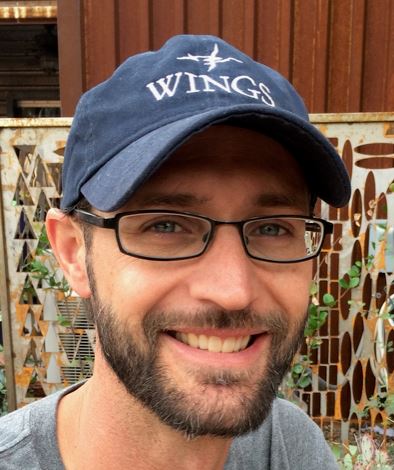
Questions? Tour Manager: Matt Brooks. Call 1-866-547-9868 (US or Canada) or (01) 520-320-9868 or click here to email.
* Tour invoices paid by check carry a 4% discount. Details here.
*If participating in both Australia tours in 2024, the flight between Melbourne and Cairns (which connects this tour to the Queensland and NSW tour) is not included in either price. It will be booked by the WINGS office and added to the invoice.
This tour is limited to eight participants with one leader.
Single rooms or rooms with en suite facilities may not be available in some places. See Tour Information for details.

